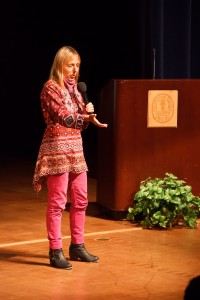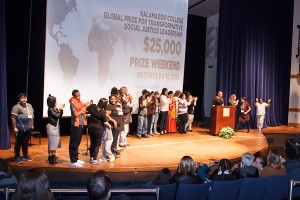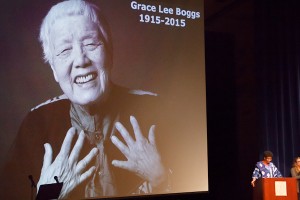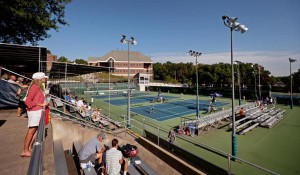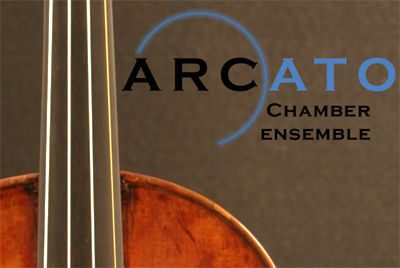Congratulations to the following Kalamazoo College students, who received awards during the Senior Awards Ceremony on June 13, 2015, in Stetson Chapel. The awards include all academic divisions, prestigious scholarships, and special non-departmental awards. Again, congratulations to all graduates and members of the Class of 2015.
FINE ARTS DIVISION
Art and Art History
THE LILIA CHEN AWARD IN ART, awarded to students in their junior or senior year who distinguish themselves through their work in ceramics, sculpture, or painting, and who exhibit strong progress in their understanding of art.
Katie Hunter
Corinne MacInnes
THE GEORGE EATON ERRINGTON PRIZE, awarded to an outstanding senior are major.
Olivia Bouchard
Allison Hammerly
THE MICHAEL WASKOWSKY PRIZE, awarded to an outstanding junior or senior art major.
Lauren Gaunt
Music
The LILLIAN PRINGLE BALDAUF PRIZE IN MUSIC, awarded to an outstanding music student.
Hannah Shaughnessy-Mogill
THE MUSIC DEPARTMENT AWARD, given by the Music Department of the College for outstanding contributions to the musical life on campus, for achievement in performance areas, and for academic achievement.
Rebecca Beery
Nicole Caddow
Athena Curtiss
Lauren Drew
Abigail Fraser
Rina Fujiwara
Tibin John
Abby Keizer
Rachel LePage
Thanh Thanh Phan
Elizabeth Uribe
THE MARGARET UPTON PRIZE IN MUSIC, awarded each year to a student designated by the Music Department faculty as having made a significant achievement in music.
Bret Linvill
Ernest (Brad) Stech
Morgan Walker
Theatre Arts
THE RUTH SCOTT CHENERY AWARD, given to a graduating senior who has excelled academically in theatre and who plans to continue the study of theatre arts following graduation.
Grace Gilmore
Jane Huffman
Anya Opshinsky
Colleen Schuldeis
THE IRMGARD KOWATZKI THEATRE AWARD, awarded to the senior who has excelled both in academic areas and in theatrical productions during the four years at the College.
Jane Huffman
THE CHARLES TULLY DESIGN AWARD, given annually to a senior who has achieved excellence in some aspect of theatre design.
Katelyn Anderson
FOREIGN LANGUAGES DIVISION
Chinese
THE CHINESE OUTSTANDING ACHIEVEMENT AWARD, recognizes seniors who have excelled in the study of the Chinese language and China-related subjects on campus and abroad in China.
Gordon Backer
Alexander Werder
Luke Winship
Classical Studies
THE CLARA H. BUCKLEY PRIZE FOR EXCELLENCE IN LATIN, awarded to an outstanding student of the language of the Romans.
Kaitlyn Greiner
THE DEPARTMENTAL PRIZE IN GREEK
Richard Woods
THE PROVOST’S PRIZE IN CLASSICS, awarded to that student who writes the best essay on a classical subject.
Kaitlyn Greiner
German
THE JOE FUGATE SENIOR GERMAN AWARD, awarded to a senior for excellence in German.
Rebecca Lennington
Japanese
THE JAPANESE NATIONAL HONOR SOCIETY, COLLEGE CHAPTER, is awarded in recognition of the student’s achievement in their study of the Japanese language and for their overall academic excellence.
Lauren Drew
Adam Eisenstein
Vageesha Liyana Gunawardana
Romance Languages
THE ALLIANCE FRANCAISE PRIZE IN FRENCH, awarded for excellence in French by an advanced student.
Haley Cartwright
Kelsey Donk
Lila Rothschild
Rolf Verhagen Metman
THE SENIOR SPANISH AWARD, given by the Department of Romance Languages for outstanding achievement in Spanish.
Allison Hammerly
HUMANITIES DIVISION
American Studies
THE DAVID STRAUSS PRIZE IN AMERICAN STUDIES, awarded for the best paper written by a graduating senior in his or her junior or senior year in any field of American Studies.
Andrea Satchwell
English
THE GRIFFIN PRIZE, awarded to the senior English major who, like Professor Gail Griffin, demonstrates an exceptional ability to bridge his/her analytical and creative work in the English department.
Allison Kennedy
THE ELWOOD H. AND ELIZABETH H. SCHNEIDER PRIZE, awarded for outstanding and creative work in English done by a student who is not an English major.
Alejandra Castillo
THE MARY CLIFFORD STETSON PRIZE, awarded for excellence in English essay writing by a senior.
Jasmine An
Gordon Backer
THE DWIGHT AND LEOLA STOCKER PRIZE, awarded for excellence in English writing: prose or poetry.
Kate Belew (poetry)
Jane Huffman (poetry)
Hamin Kang (fiction)
Katherine Rapin (nonfiction/journalism)
History
THE JAMES BIRD BALCH PRIZE, for the showing academic excellence in American History.
Samantha Foran
THE HISTORY DEPARTMENT AWARD, given for outstanding work in the major.
Abigail Fraser
Philosophy
THE DEPARTMENT OF PHILOSOPHY PRIZE, awarded for excellence in any year’s work in philosophy.
Morgan Jennings
Christian VanHouten
THE HODGE PRIZE IN PHILOSOPHY, awarded to that member of the graduating class who has the highest standing in the field.
Morgan Jennings
Religion
THE MARION H. DUNSMORE MEMORIAL PRIZE IN RELIGION, awarded to a graduating senior for excellence in the major.
Caroline Barnett
NATURAL SCIENCES AND MATHEMATICS DIVISION
Biology
THE H. LEWIS BATTS PRIZE, awarded to the senior who has done the most to support the activities of the Biology Department and to further the spirit of collegiality among students and faculty in the Department.
Asia Liza Morales
THE ROBERT BZDYL PRIZE IN MARINE BIOLOGY, awarded to one or more students with demonstrated interest and ability in marine biology or related fields.
Shelby Retherford
THE DIEBOLD SCHOLAR AWARD, given to one or more seniors in recognition of excellence in the oral or poster presentation of the SIP at the Diebold Symposium.
Emily Holloway
Jack Kemper
Dylan Shearer
Austin Voydanoff
THE WILLIAM E. PRAEGER PRIZE, established by the faculty in the Biology Department and awarded to the most outstanding senior major in Biology, based on academic achievement in the discipline.
Lucy Mailing
Austin Voydanoff
Chemistry
THE ANNUAL UNDERGRADUATE AWARD IN INORGANIC CHEMISTRY, sponsored by the American Chemical Society Division of Inorganic Chemistry, to an undergraduate student planning on pursuing graduate studies in chemistry.
Mojtaba Akhavantafti
THE ANNUAL UNDERGRADUATE AWARD IN ORGANIC CHEMISTRY, sponsored by the American Chemical Society and subcommittee for the Division of Organic Chemistry, to an undergraduate student who displays significant aptitude for a career in organic chemistry.
Vageesha Liyana Gunawardana
THE OUTSTANDING CHEMISTRY STUDENT FROM KALAMAZOO COLLEGE, sponsored by the Kalamazoo Section of the American Chemical Society and is given to the graduating senior who has demonstrated leadership in the chemistry department and plans to pursue graduate studies in chemistry.
Thanh Thanh Phan
THE KURT KAUFMAN FELLOW, given annually to seniors who receive Honors in the Senior Individualized Project (SIP) conducted with faculty in the Chemistry Department.
Rina Fujiwara
Mathematics and Computer Science
THE CLARKE BENEDICT WILLIAMS PRIZE, awarded to that member of the graduating class who has the best record in mathematics and the allied sciences.
Tibin John
Physics
THE JOHN WESLEY HORNBECK PRIZE, awarded to a senior with the highest achievement for the year’s work in advanced physics toward a major.
Mojtaba Akhavantafti
PHYSICAL EDUCATION DIVISION
Physical Education
THE GEORGE ACKER AWARD awarded annually to a male athlete who in his participation gave all, never quit, with good spirit supported others unselfishly, and whose example was inspirational.
Clayton Weissenborn
THE TISH LOVELESS AWARD, given by the Department of Physical Education to the outstanding senior female athlete.
Emily Lindsay
THE KALAMAZOO COLLEGE ATHLETIC ASSOCIATION AWARD, for a graduating senior who has most successfully combined high scholarship with athletic prowess.
Dylan Shearer
THE MARY LONG BURCH AWARD, for a senior woman who has manifested interest in sports activities and excelled in scholarship.
Rachel Dandar
THE C. W. “OPIE” DAVIS AWARD, awarded to the outstanding senior male athlete.
Guilherme Guedes
THE KNOECHEL FAMILY AWARD, awarded to a senior male and a senior female member of the swim teams in recognition of demonstrated excellence in both intercollegiate swimming and academic performance.
Guilherme Guedes
Dylan Shearer
THE CATHERINE A. SMITH PRIZE IN WOMEN’S ATHLETICS, awarded to a woman athlete who in her participation gave all, never quit, with good spirit supported others unselfishly, and whose example was inspirational.
Olivia Bouchard
Bronte Payne
SOCIAL SCIENCES DIVISION
Anthropology and Sociology
THE RAYMOND L. HIGHTOWER AWARD, given to a graduating senior for excellence in and commitment to the disciplines of sociology and anthropology and leadership in the Department of Anthropology and Sociology.
Elisa Contreras
Mariah Hennen
Economics and Business
THE WILLIAM G. HOWARD MEMORIAL PRIZE, awarded to a senior for excellence in academic work in an economics or business major.
Drew Hopper
Bret Linvill
Phillip Mulder
Emerson Talanda-Fisher
Scott Wharam
THE PROVOST PRIZE IN BUSINESS AND ECONOMICS, awarded to a senior for excellence in academic work in a business major.
William Cagney
Tessa Lathrop
Human Development and Social Relations
THE HUMAN DEVELOPMENT AND SOCIAL RELATIONS PRIZE, awarded for leadership in the major, reflecting commitment to inter-disciplinary thinking and social justice.
Grace Manger
Political Science
THE E. BRUCE BAXTER MEMORIAL AWARD, awarded to a senior showing outstanding development in the field of political science.
Skylar Young
THE WILLIAM G. HOWARD MEMORIAL PRIZE, awarded for excellence in a year’s work in political science.
Colin Cepuram
Psychology
THE MARSHALL HALLOCK BRENNER PRIZE awarded to an outstanding student for excellence in the field of psychology.
Alexandra Groffsky
THE XARIFA GREENQUIST MEMORIAL PSYCHOLOGY DEPARTMENT AWARD, given in recognition of distinctive service to students and faculty in psychology by a student assistant.
Grace Bowe
Elizabeth Hanley
Kelsey Hill
Jenna Holmes
THE RICHARD D. KLEIN SENIOR AWARD IN PSYCHOLOGY, awarded to a senior psychology major for an outstanding SIP oral presentation.
Lyla Rothschild
THE RICHARD D. KLEIN SENIOR AWARD IN PSYCHOLOGY, given for outstanding contributions to the community
Hannah Bogard
Elizabeth Cabrera
Viridiana Carvajal
THE DONALD W. VAN LIERE PRIZE, given for excellence in psychology research.
Rachel LePage
Lyla Rothschild
Jessica Varana
Jeffery Washington
THE DONALD W. VAN LIERE PRIZE, given for excellence in psychology coursework.
Alexandra Groffsky
Elizabeth Hanley
Jenna Holmes
Tessa Lathrop
Perri Nicholson
Women’s Studies
THE CATHERINE A. SMITH PRIZE IN HUMAN RIGHTS, awarded to a senior who has been active on campus in promoting human rights, furthering progressive social and cultural change, and combating violence, repression, and bigotry.
Andrea Johnson
THE LUCINDA HINSDALE STONE PRIZE, awarded to a student whose scholarship, research or creative work in women’s studies, in the form of a SIP or other academic work, is most impressive.
Maya Edery
COLLEGE AWARDS
THE GORDON BEAUMONT MEMORIAL AWARD, awarded to the deserving student who displays qualities of selflessness, humanitarian concern, and willingness to help others, as exemplified in the life of Gordon Beaumont.
Kacey Cook
Bronte Payne
THE HENRY AND INEZ BROWN AWARD is awarded in recognition of outstanding participation in the College community.
David DeSimone
Tibin John
THE VIRGINIA HINKELMAN MEMORIAL AWARD is awarded to a deserving student who displays a deep concern for the well-being of children, as demonstrated through career goals in the field of child welfare.
Mele Makalo
THE ALPHA LAMBDA DELTA MARIA LEONARD SENIOR BOOK AWARD, given to the Alpha Lambda Delta member graduating with the highest GPA.
Jasmine An
THE BABETTE TRADER CAMPUS CITIZENSHIP AND LEADERSHIP AWARD, awarded to that member of the graduating class, who has most successfully combined campus citizenship and leadership with scholarship.
Elisa Contreras
Madeline Sinkovich
THE MAYNARD OWEN WILLIAMS MEMORIAL AWARD, for the best student entry in the form of an essay, poetry, paintings, sketches, photographs, or films derived from Study Abroad.
Kate Belew
Kelsey Donk
Luke Winship
The Mary Jane Underwood Stryker Center for Civic Engagement recognizes THE HAM SCHOLARS, who work through community partnerships to empower girls and young women to lead and advocate.
Maya Edery
The Mary Jane Underwood Stryker Institute for Service-Learning recognizes LAPLANTE STUDENT SCHOLARS who have shown outstanding dedication to civic engagement and who design and lead community programs that promote a more just, equitable and sustainable world.
Jasmine An
Alejandra Castillo
Kacey Cook
Nolan Foust
Allison Kennedy
Andrea Satchwell
Mary Tobin
The Mary Jane Underwood Stryker Center for Civic Engagement recognizes the VIBBERT SCHOLARS, students who honor and exemplify the life and spirit of Stephanie Vibbert–scholar, activist, poet, feminist and artist–by leading programs that promote equity and justice through the arts and feminist organizing.
Cheyenne Harvey
The Mary Jane Underwood Stryker Center for Civic Engagement recognizes the DEMOORE/VONK SCHOLARS, students who “carry on the work of Howard DeMoore and Tony Vonk … by turning lives around,” working with incarcerated youth and adults and promoting restorative justice.
Hannah Bogard
Mele Makalo
THE SENIOR LEADERSHIP RECOGNITION AWARD is awarded to students who have provided key elements of leadership in their organizations, athletic teams, academic departments, employment, and the wider Kalamazoo community. Students were nominated by faculty and staff members in January. Seniors eligible for this award also had to meet a minimum cumulative Grade Point Average requirement and be in good academic and social standing at the College.
Mojtaba Akhavantafti
Jasmine An
Benjamin Baker
Caroline Barnett
Hannah Bogard
Olivia Bouchard
Elizabeth Cabrera
Haley Cartwright
David DeSimone
Scott Devine
Carl Ghafari
Alexandra Gothard
Cheyenne Harvey
Jane Huffman
Adriana Jarquin
Allison Kennedy
Emily Lindsay
Vageesha Liyana Gunawardana
Mele Makalo
Hannah Maness
Scott Manski
Natalie Melnick
Roxanna Menchaca
Asia Morales
Philip Mulder
Stephen Oliphant
Hannah Olsen
Bronte Payne
Adam Peters
Samuel Rood
Jenna Sexton
Colin Smith
Shang Sun
Mary Tobin
Luke Winship


